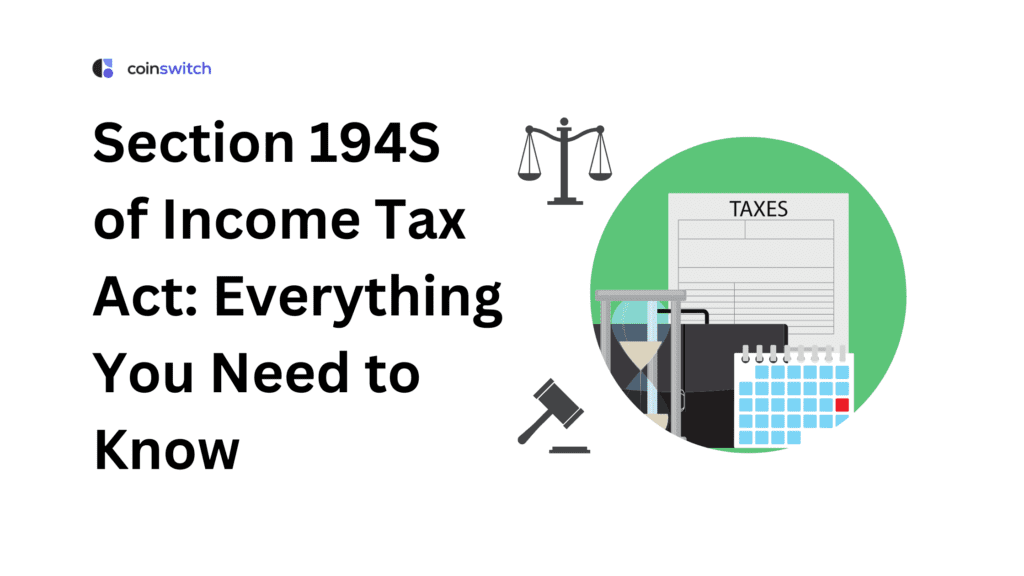Introduction of Section 194S of Income Tax Act
If you have dabbled in crypto in the last few years, you would be familiar with Section 194S of the Income Tax Act. It is an important provision of the Income Tax Act, particularly for crypto traders and investors in India.
Essentially, Section 194S mandates the deduction of 1% TDS on payments made on the transfer of VDAs. Virtual Digital Assets (VDAs) include cryptos and non-fungible tokens (NFTs). Let’s dig a little deeper into Section 194S.
What is Section 194S of the Income Tax Act?
Section 194S is a relatively new addition to the Indian Income Tax Act, introduced in the 2022 budget by Finance Minister Nirmala Sitharaman. The section became effective from July 1, 2022, and it concerns the deduction of TDS on the transfer of VDAs.
Section 194S mandates a 1% TDS on the transfer of VDAs such as cryptos, NFTs, and other virtual digital assets. To simplify it, if you trade VDAs, a 1% TDS must be deducted on payments for transfers.
Read More: Income Tax Slabs and Rates: 2025–2026 Taxpayers Best Guide
Key highlights of Section 194S guidelines
The key highlights of Section 194S guidelines that help to understand how TDS applies to VDA transactions are:
- TDS rate: A 1% TDS is deducted on the total amount paid for buying or transferring virtual digital assets like cryptos or NFTs.
- Threshold Limit: TDS under Section 194S is applicable if the payment for the transfer of VDA exceeds ₹50,000 during the financial year for a Specified Person as defined below:
- For individuals/HUFs who do not have income under ‘profits and gains of business or profession’.
- For individuals or HUFs having business income up to ₹1 crore
- For individuals or HUFs having professional receipts up to ₹50 lakh
The threshold for TDS deduction is ₹10,000 for others.
- Tax ID requirement: Both buyer and seller must have a Tax Identification Number (TIN) for the TDS to be valid.
- Timing of payment: TDS must be deducted either when the amount is credited to the seller or when it’s paid, whichever is first.
Read More: Section 115BBH: Virtual Digital Assets Taxation Scheme (Cryptocurrency Tax)
Applicability of Section 194S
Section 194S of the Income Tax Act applies to anyone making payments for buying or transferring VDAs.
- It applies to: Individuals and businesses that deal in crypto or digital assets.
- Payment threshold: TDS is only deducted if the payment crosses a certain amount, so smaller transactions are not affected.
Transfer of VDA (in cash) through an exchange (Who does not own VDA)
In cases where someone buys crypto from an exchange that does not own the VDA, the responsibility of deducting and depositing TDS lies with the exchange. The exchange must deduct 1% TDS on behalf of the buyer.
Exchange of VDA (in kind) via broker, barter for another one
When VDAs are exchanged for another crypto, for example, BTC for ETH, and no cash is involved, TDS must be deducted by both parties involved. In such a case, each party is responsible for deducting 1% TDS on payment made on the transfer of VDA. However, if the exchange is done via a platform, the platform can deduct and deposit TDS on behalf of both parties. But if there’s no exchange involved in the transaction, the buyer must deduct 1% TDS and deposit it with the government.
When is Section 194S invoked?
Section 194S applies when:
- When an individual or business sells or transfers crypto and other virtual assets.
- The total VDA value transferred crosses the threshold limit
Steps to comply with Section 194S
To ensure that taxpayers comply with Section 194S, they must follow the following precautionary steps:
- Determine TDS applicability: The first and most important step is to check if the total crypto transfer value exceeds the threshold for the financial year.
- Deduct 1% TDS: If applicable, deduct the 1% TDS at the time of payment or credit, whichever is earlier.
- Issue TDS certificate: Provide the seller with a TDS certificate (Form 16A) showing the deducted and deposited tax.
- Maintain transaction records: Always keep documents such as invoices, PAN details, and payment proofs for future reference and audits.
Payment Gateways and TDS under Section 194S
If you buy or sell VDAs using a payment gateway like Razorpay or PayU, the payment gateway does not need to deduct TDS on the transaction. This is to avoid double deduction since the buyer or the crypto exchange facilitating the trade is already responsible for deducting the 1% TDS under Section 194S.
So, if TDS is being handled by the buyer or exchange, the payment gateway doesn’t have to do it again.
Consequences of non-compliance with Section 194S
The government of India mandates Section 194S, and non-compliance with this section can result in severe consequences, such as:
- Penalties and interest: Similar to the penalties for violating provisions of the Income Tax Act in India, taxpayers who fail to comply with Section 194S can face penalties and interest on the unpaid TDS. The penalty can be equal to the amount of tax not deducted or paid.
- Legal action: In severe cases, non-compliance with Section 194S may result in legal action, including audit and investigation, and could lead to imprisonment.
- Impact track record: Since Section 194S was implemented to track VDA transactions, the government can track every transaction. Non-compliance can tarnish your track record, potentially impacting future transactions.
- Late filing fine: Under Section 234E, if taxpayers delay filing their TDS or Tax Collected at Source (TCS) return, they will be charged a late fee of ₹200 per day from the due date until they file it. However, the total late fee cannot exceed the total TDS or TCS amount they were supposed to deposit.
Best practices to avoid pitfalls under Section 194S
To ensure that you stay compliant with Section 194S and avoid pitfalls, here are some practices you can adopt:
- Maintain transaction records: Always keep detailed records of all transactions that include VDAs. With several digital record-keeping tools options available, it’s easier than ever to record all tax-related documents electronically or digitally.
- Educate yourself on VDA-related tax: Since VDA-related taxes are relatively new, it is recommended to educate yourself on the basics, like TDS and its application, what constitutes a VDA, and the relevance of Section 194S.
- Leverage tools and technology: There are several tools and plugins available to make crypto tax easier. For example, one can leverage platform features or software tools that help automate TDS deduction and reporting.
- Plan for tax liabilities: It’s important to incorporate your tax responsibilities in your overall financial planning. While investing in digital assets, TDS applies, so ensure to plan your finances accordingly. This will help you cover any tax that needs to be paid without facing a sudden financial burden.
Stay informed: The regulatory stance on virtual digital assets is still in development, and the rules and regulations may update or change as the digital space evolves. Stay on top of the latest developments and stay informed.
FAQs
1. What is the treatment of income under 194S?
Income that comes under the purview of Section 194S (crypto or VDA transactions) should be reported under “Capital Gains” if treated as investments, or “Business/Profession” if traded frequently.
2. Which head of income tax is 194S taxable under?
Section 194S-related income is taxable under “Capital Gains or Business Income,” depending on the nature of transactions.
3. What is Section 194 of the Income Tax Act?
Section 194 of the Income Tax Act mandates that before a company pays a dividend to a resident, it must first deduct tax at the applicable rate. This ensures that tax is collected in advance before the dividend is distributed to the recipient. TDS has to be deducted at the rate of 10% if the total dividend received for the year exceeds ₹10,000.
4. What is the TDS for a monthly salary of ₹50,000?
If the total annual income exceeds the basic exemption limit, TDS may apply as per the income tax slab rates. For a ₹50,000 monthly salary (₹6L per annum), no TDS would be applicable if the employee opts for the new tax regime.








